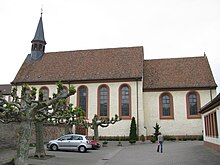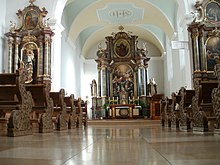St. Magdalena Monastery (Speyer)
The St. Magdalena is a convent of Dominican nuns in Speyer .
history
monastery
In St. Leon on the right bank of the Rhine there was a community of Reuerinnen around 1227 , which moved to Speyer in 1228. The monastery, where it is still located today, was built on donated land north of the Speyer Cathedral . In 1304 the penitent women asked for admission to the Dominican order, which Pope Benedict XI. was approved. In the Palatinate War of Succession in 1689, the monastery burned down like the entire city and the sisters had to flee. Ten years later they returned and rebuilt the monastery. In the wars after the French Revolution , the sisters had to leave the monastery four times between 1792 and 1795. They were able to return in 1797, but in 1802 the monastery was secularized . The Dominican women were again forced to leave the convent and the buildings were sold by the state. In 1807 they managed to buy back the complex with financial help from relatives. But they could only live there secretly, without religious clothing, as a spiritual community.
In 1811 a canon of Freising , Count Damian Hugo Philipp von Lehrbach , moved into a modest apartment in the monastery as a pensioner. Under the care of the sisters he lived here in a very secluded life and looked after them in spiritual matters. From his room he had a window broken into the choir of the church so that he could always see the high altar or tabernacle . A contemporary monastery chronicle describes him as a "great example of piety" . The monastery church of St. Magdalena became the main place of worship in the city during this time, as the cathedral was in a ruinous state. The diocese of Speyer and its own bishop no longer existed, until 1817 Speyer belonged to the French grand diocese of Mainz . On his death in 1815, Count Lehrbach donated the majority of his property to the church and is considered a special benefactor of the re-established Diocese of Speyer. He left the Magdalenenkonvent u. a. a beautiful measuring cup .
In 1828 the monastery was officially rebuilt by King Ludwig I - the Palatinate was now part of the Kingdom of Bavaria . Associated with this was the obligation to take over the Catholic girls' education in Speyer. During the period of National Socialism all schools of the monastery were closed. Then in 1937/38 25 of the sisters went to Peru and Brazil and opened schools there. In Germany, due to a lack of young people, all schools had to be closed or given to other providers by 2010. The buildings of the old monastery school were transferred to the Speyer diocese. The editors of the diocese newspaper “der pilger” moved in there and in 2012 the diocese's church music center was established here.
schools
The sisters raised children in the Speyer suburb of Hasenpfuhl as early as the 14th century. After the monastery was rebuilt, the first Catholic girls' school was opened in Speyer in 1829. In 1881 a new school building was built. From 1923 to 1931 Edith Stein was a teacher at the monastery schools in Speyer. Outside the city, the sisters were also responsible for schools in Ludwigshafen am Rhein (today Geschwister-Scholl-Gymnasium ), Mannheim (girls ' secondary school) and Gemünd (housekeeping school). In 1937/38 all monastery schools were closed by the National Socialists.
After the Second World War , the sisters in Speyer opened, among other things, a girls' elementary school, a secondary school (today Edith-Stein-Gymnasium ), several vocational schools and a technical school for social affairs, all of which were closed or given up over time due to a lack of young people. In 2013 this tradition is to be continued and an all-day elementary school with a musical focus will be founded.
Monastery complex
The extensive monastery district is located in the northwest of Speyer not far from the cathedral to the south . It is classified as a monument zone within the meaning of the Rhineland-Palatinate Monument Protection Act. At the entrance there is a late-Wilhelminian gate from 1889. Above is a relief of the coat of arms with the inscription "Veritas", on the back a late Baroque Madonna. In the historical city wall there are old grave crosses, mostly from the 18th century. The former schoolhouse dates from 1832. The single-storey building is covered with a hipped roof.
The monastery church of St. Maria Magdalena dates back to the 13th century. The walls of the square choir with two corner columns and Gothic capitals date from this period . The six-axis nave was built around 1700. On the south side there is a baroque column portal. The high altar and the two side altars date from the 18th century.
On the left side altar of the church is a copy of the famous Speyer image "Patrona Spirensis", which the French revolutionaries and their helpers burned in January 1794 when the Speyer Cathedral was sacked. Canon Karl Joseph von Mirbach (1718–1798) suffered so much from this loss that he ordered in his will that the Speyer sculptor Peter Anton Linck (brother of the Palatinate court sculptor Franz Conrad Linck ) should get an exact copy of the old figure at his own expense which will later be put up again in the cathedral or in another church in Speyer. The Madonna, donated by Mirbach, has been in the monastery church since 1810, in the cathedral there is a modern figure from 1930.
literature
- Hans Caspary (edit.), Georg Dehio (start.): Handbook of German art monuments : Rhineland-Palatinate, Saarland . Munich 1984, ISBN 3-422-00382-7 .
Individual evidence
- ^ Website on the history of the monastery
- ↑ Joseph Schwind : Damian Hugo Philipp Graf von und zu Lehrbach (1738-1815) the benefactor of the Speyer Cathedral , Speyer, Jäger'sche Buchdruckerei, 1915
- ^ Article on the Sisters' Cup
- ↑ Diocese of Speyer June 4, 2010 ( Memento from January 27, 2016 in the Internet Archive )
- ^ Diocese of Speyer January 20, 2012
- ^ Diocese of Speyer January 20, 2012 ( Memento from January 27, 2016 in the Internet Archive )
- ^ Fritz Klotz: Domkapitularische Höfe, houses, house squares and gardens in Speyer, in the 18th century , page 39, volume 14 of: Schriften des Diözesan-Archivs Speyer , 1991
- ^ Peter Joseph Strange : Contributions to the genealogy of the noble families , issue 5, pages 56 and 57, Cologne 1867; Digital scan
Web links
- St. Magdalena Monastery
- General Directorate for Cultural Heritage Rhineland-Palatinate: Informational directory of cultural monuments Free city of Speyer (PDF file; 1.26 MB)
Coordinates: 49 ° 19 ′ 12.1 ″ N , 8 ° 26 ′ 34.1 ″ E




